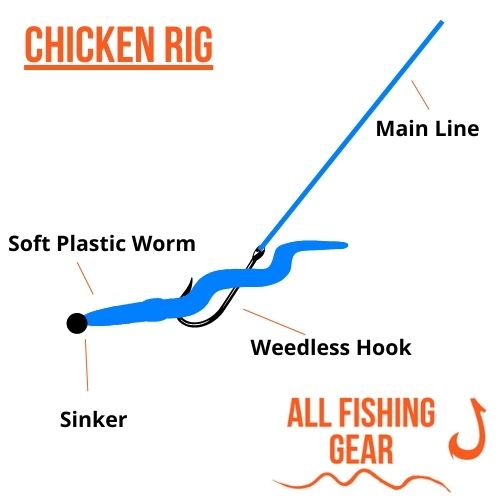If you’re a fan of the Neko rig, there’s a new style of finesse lure presentation that you’ll certainly want to learn more about called the Chicken rig. This highly successful rig was invented just a few years ago by legendary angler and lure maker, Gary Yamomoto.
In this article, we’ll break down what a Chicken rig is, as well as the different ways you can add this technique to your fishing strategy to maximize your efforts when the conditions are right.
Table of Contents
What is the Chicken Rig?
The Chicken rig has a lot of similarities to the wildly popular Neko rig that has taken the bass fishing world by storm in the last few decades. The Neko rig got its name from the fact that it is capable of attracting bites from tons of fish in a very simple, easy technique that anglers of all skill levels can use. In fact, the term “Neko-sogi” translates to “lure that catches fish like a vacuum cleaner” in Japanese and the Chicken rig has much of the same qualities.
The Chicken rig delivers a very distinct action that’s comparable to the Neko rig in both how it’s supposed to be fished along the bottom, as well as the action it produces while the bait is sinking down to the bottom. What makes the Chicken rig more effective than the Neko is the fact that it can be used in certain areas where the Neko is more likely to get snagged.
The Chicken rig is very straightforward and simple to tie-on and use. It involves using any kind of soft plastic worm that has a straight body. Most anglers prefer to use a 4 to 6-inch stickworm, but some companies have started producing specialized soft plastic worms that are designed to be used exclusively with the Chicken rig. One such example is the Berkley Powerbait Flute Worm that comes in a few size and color options.
The most effective hooks used with the Chicken rig are usually those that are designed for Neko rigging, particularly in a 1/0 or 2/0 size depending on the size of the worm you choose. Next, you’ll need a typically nail weight, or any other that is intended to be used in a Neko rig that will fit easily inside the tip of the worm.
You’ll set the soft plastic worm up in the same way you would for a Neko rig, but instead of using an O-ring to place the hook, you’ll bury the hook in the same way that’s used for a Texas or Carolina rig. The main difference between the Chicken and the Neko rig is that the former is rigged in a weedless fashion with the hook placed about two-thirds of the way down the worm near the tail end.
Some anglers will actually use a small drywall screw to serve as their sinker as the screw’s head works as an added sinker that causes the worm to sit upright on the bottom. However, there are specialized sinkers that you can buy that serve this purpose with the Chicken rig.

How to Fish the Chicken Rig
The true advantage of the Chicken rig is that you can fish it practically anywhere. It’s very effective when fished along the bottom in the same situations where you might use a Neko. The best thing about the Chicken rig is that it’s totally weedless, so you can fish it in heavier cover around brush piles, docks, vegetation, and anywhere else you want.
You’ll basically use the same type of twitching action on the Chicken rig that you would with the Neko. You can gently twitch it as you bounce it along the bottom or around cover at a speed that you feel comfortable with.
The Chicken rig is best used with a medium-heavy spinning rod and reel setup. It’s recommended that you use braided line for fishing it around cover, or you can opt for 15 or 20 pound test fluorocarbon line if the water is especially clear.
A useful tip for getting the most out of the Chicken rig is to gently twitch it as it is falling toward the bottom once it hits the water. This makes the rig look like a small bait fish slowly working its way to the bottom and can trigger strikes from fish before it ever gets there.
Conclusion
The best way to fish the Chicken rig is to use weights, hooks and worms that are specially-designed for this particular rig. It is extremely effective when bass tend to stick close to the bottom, but is just as versatile as the Texas rig in the fact that you can use it literally any time of the year in any part of the water.
The Chicken rig is a solid finesse fishing method that tends to attract bites from bigger fish, so this is certainly one to add to your fishing arsenal.
